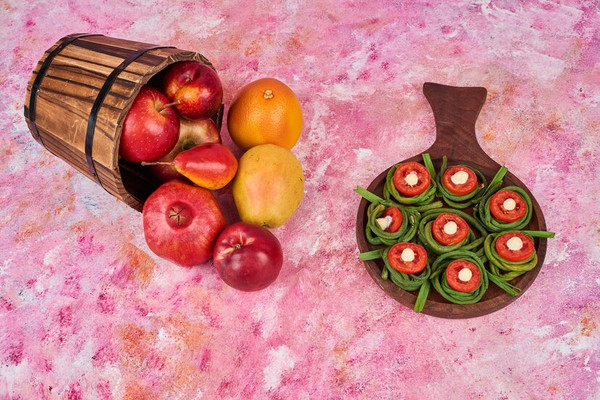20 Famous Still Life Paintings: Guide to Artists and Masterpieces
Posted by MintSuper Art on 15th Jan 2025
Still life paintings have caught art enthuasiats and audiences attention for centuries as they offer a unique glimpse into the modern life, artistry, symbolism, and techniques of their creators. Exploring these kind of art form and some of the most influential artists will make you understand the entire art history and what each art means.
Still life paintings focus on inanimate objects such as flowers, fruits, and everyday items, often arranged to show deeper meanings. As it grew prominently during the Renaissance, the genre evolved across eras, reflecting societal values, spiritual beliefs, and artistic innovations.
This comprehensive article showcases the beauty and cultural significance of famous still life artists, diving deep into the lives of the most renowned painters, the meaning behind their greatest paintings, and the techniques that define them.
The Artist's Famous Still Life Paintings
Still life paintings are more than aesthetic displays that are used in some parties and events—they serve as windows into the thoughts, aspirations, and philosophies of their time. Each masterpiece carries a narrative, brought to life through the artist’s skill and ingenuity.
Below are 20 iconic still life paintings and the stories behind their creation.
Still Life with Basket of Fruit (Caravaggio, c. 1599)
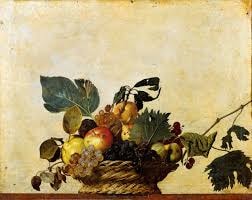
- Title and Creator: Still Life with Basket of Fruit by Michelangelo Merisi da Caravaggio.
- Artist’s Contribution: Caravaggio revolutionised Baroque art with his dramatic use of light and realistic detail, making this painting one of the earliest examples of standalone still life.
- Creation Period: Late 16th century, amidst the Counter-Reformation. Cultural Context: Reflects the era’s focus on religious themes and the transient nature of life.
- Main Theme: A display of ripened fruits, some with signs of decay, symbolising the passage of time.
- Key Elements: A meticulously detailed basket containing grapes, figs, and apples on a ledge.
- Techniques Used: Masterful chiaroscuro creates a striking contrast between light and shadow.
- Symbolism: The decay in some fruits symbolises mortality and the impermanence of life. Significance: Pioneered still life as a standalone genre, influencing generations of artists.
- Impact: Showcased realism and symbolism in still life, elevating the genre’s status in art history.
Still Life with a Lobster (Willem Kalf, 1643)
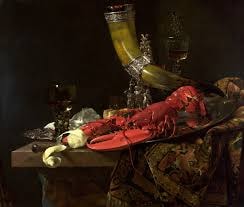
- Title and Creator: Still Life with a Lobster by Willem Kalf.
- Artist’s Contribution: A master of Dutch Golden Age still life, Kalf’s works are known for their opulence and precision.
- Creation Period: Mid-17th century, during the Dutch Golden Age.
- Cultural Context: Reflects the wealth and prosperity of the Dutch middle class.
- Main Theme: A luxurious arrangement of food and drink symbolising abundance and indulgence.
- Key Elements: Features a lobster, fine china, and a polished goblet.
- Techniques Used: Trompe-l’œil adds depth and realism, while the composition highlights texture and reflection.
- Symbolism: The lobster represents luxury, while the fragile goblet hints at the fleeting nature of wealth.
- Significance: Captures the opulence of the time while subtly critiquing materialism.
- Impact: Cemented Kalf’s reputation as a leading still life artist of his era.
Vanitas Still Life (Pieter Claesz, 1630)
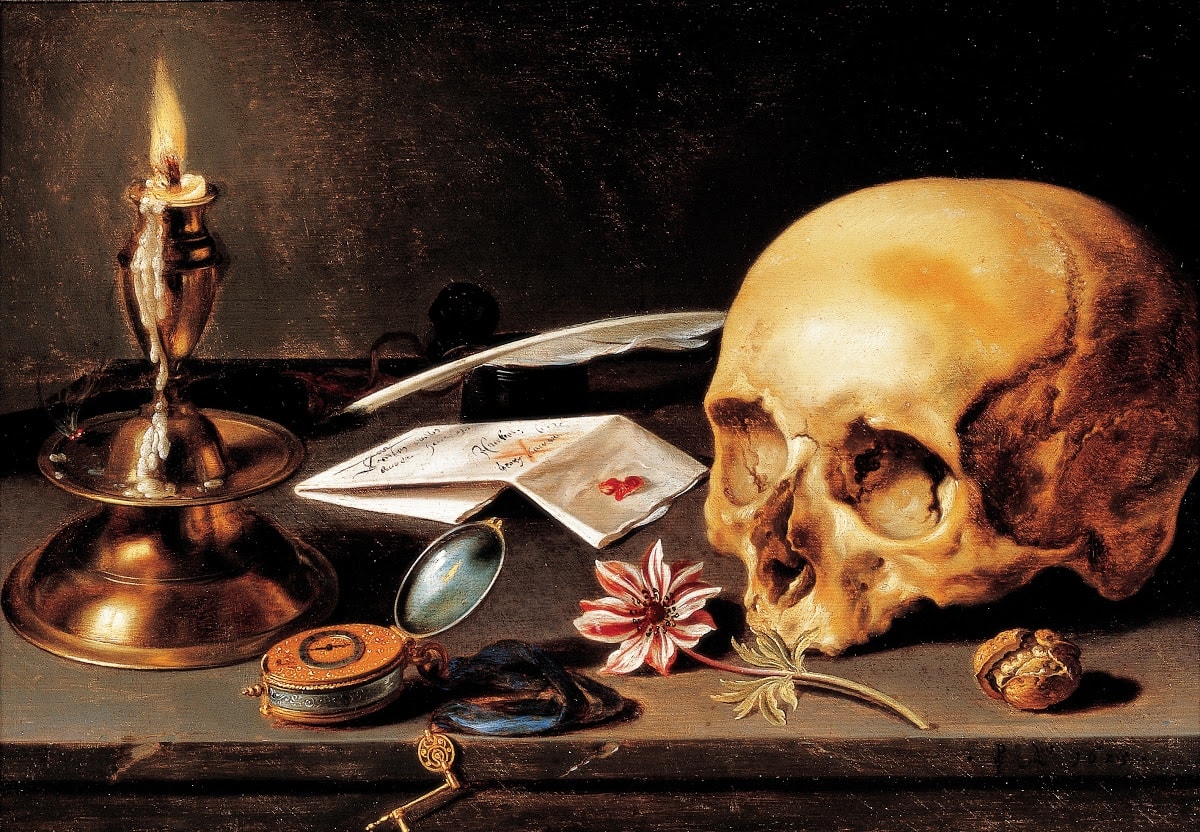
- Title and Creator: Vanitas Still Life by Pieter Claesz.
- Artist’s Contribution: A pioneer of vanitas painting, Claesz emphasised the transience of life through symbolism.
- Creation Period: Early 17th century, during the Dutch Golden Age.
- Cultural Context: Reflects the era’s preoccupation with mortality and the afterlife.
- Main Theme: The inevitability of death and the futility of earthly possessions.
- Key Elements: Features a skull, extinguished candle, and timepiece.
- Techniques Used: Subtle lighting and muted tones evoke a sombre mood.
- Symbolism: The skull and candle symbolise mortality, while the timepiece underscores the fleeting nature of time.
- Significance: Exemplifies vanitas symbolism in still life.
- Impact: Influenced moralistic themes in art, resonating with audiences across generations.
Flowers in a Glass Vase (Jan Brueghel the Elder, 1608)
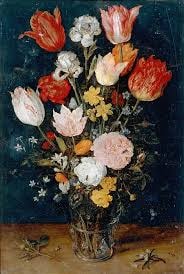
- Title and Creator: Flowers in a Glass Vase by Jan Brueghel the Elder.
- Artist’s Contribution: Known as the "Flower Brueghel," he was celebrated for his intricate floral compositions.
- Creation Period: Early 17th century, amidst the flourishing trade of exotic flowers.
- Cultural Context: Reflects the growing fascination with botany during the Dutch Golden Age.
- Main Theme: A vibrant array of flowers, showcasing both beauty and impermanence.
- Key Elements: Features a detailed bouquet with flowers such as tulips and roses.
- Techniques Used: Delicate brushwork and a precise arrangement create a lifelike quality.
- Symbolism: Each flower carries its own meaning—tulips represent wealth, while wilting petals remind viewers of mortality.
- Significance: Highlights the intersection of art and botany.
- Impact: Elevated floral still life painting, inspiring countless artists.
Still Life with Gilt Goblet (Willem Claesz Heda, 1635)
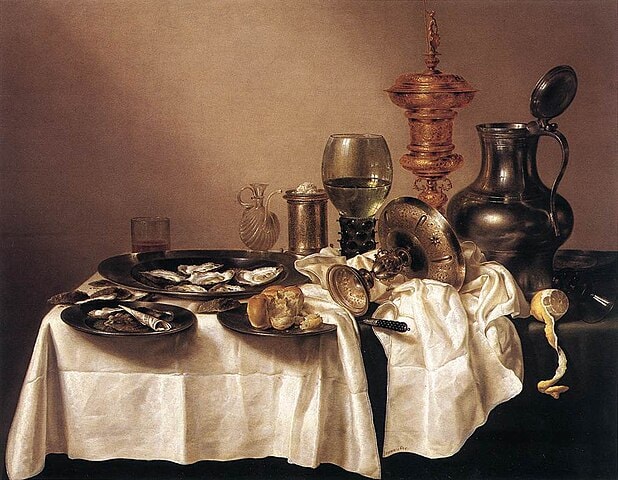
- Title and Creator: Still Life with Gilt Goblet by Willem Claesz Heda.
- Artist’s Contribution: A master of "breakfast pieces," Heda’s works often featured luxurious table settings.
- Creation Period: Mid-17th century, during the Dutch Golden Age.
- Cultural Context: Reflects the prosperity and refinement of Dutch society.
- Main Theme: A display of wealth and elegance, juxtaposed with subtle hints of impermanence.
- Key Elements: Features a gilded goblet, lemon peel, and bread.
- Techniques Used: Impeccable attention to light and texture, capturing reflections and shadows.
- Symbolism: The lemon peel represents the fleeting nature of pleasure.
- Significance: Exemplifies technical mastery in still life painting.
- Impact: Influenced the portrayal of opulence in still life art.
The Basket of Apples (Paul Cézanne, c. 1893)
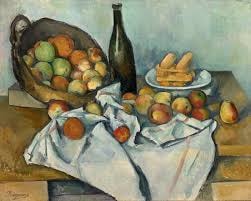
- Title and Creator: The Basket of Apples by Paul Cézanne.
- Artist’s Contribution: Known as the "father of modern art," Cézanne bridged Impressionism and Cubism.
- Creation Period: Late 19th century, during the rise of Post-Impressionism.
- Cultural Context: Reflects a shift towards abstraction and experimentation.
- Main Theme: A simple yet dynamic arrangement of apples and a bottle.
- Key Elements: Features distorted perspectives and vibrant colours.
- Techniques Used: Bold brushstrokes and layered colour create depth.
- Symbolism: The imperfect arrangement reflects the complexity of perception.
- Significance: Redefined the boundaries of still life painting.
- Impact: Inspired modernist movements and artists.
Sunflowers (Vincent van Gogh, 1888)
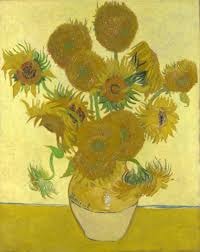
- Title and Creator: Sunflowers by Vincent van Gogh.
- Artist’s Contribution: Van Gogh’s expressive brushwork and use of vivid colours revolutionised modern art.
- Creation Period: 1888, during his time in Arles, France.
- Cultural Context: This painting reflects van Gogh’s fascination with light and nature and his desire to symbolise gratitude.
- Main Theme: A vibrant bouquet of sunflowers in a simple vase.
- Key Elements: Features dynamic brushstrokes and a rich palette of yellows and oranges.
- Techniques Used: Impasto creates texture and depth, while bold colours evoke warmth.
- Symbolism: The sunflowers represent gratitude, hope, and renewal.
- Significance: One of the most recognisable still life paintings, showcasing van Gogh’s unique style.
- Impact: Immortalised sunflowers as a symbol of hope and creativity.
Still Life with Apples and a Pot of Primroses (Paul Cézanne, 1890)
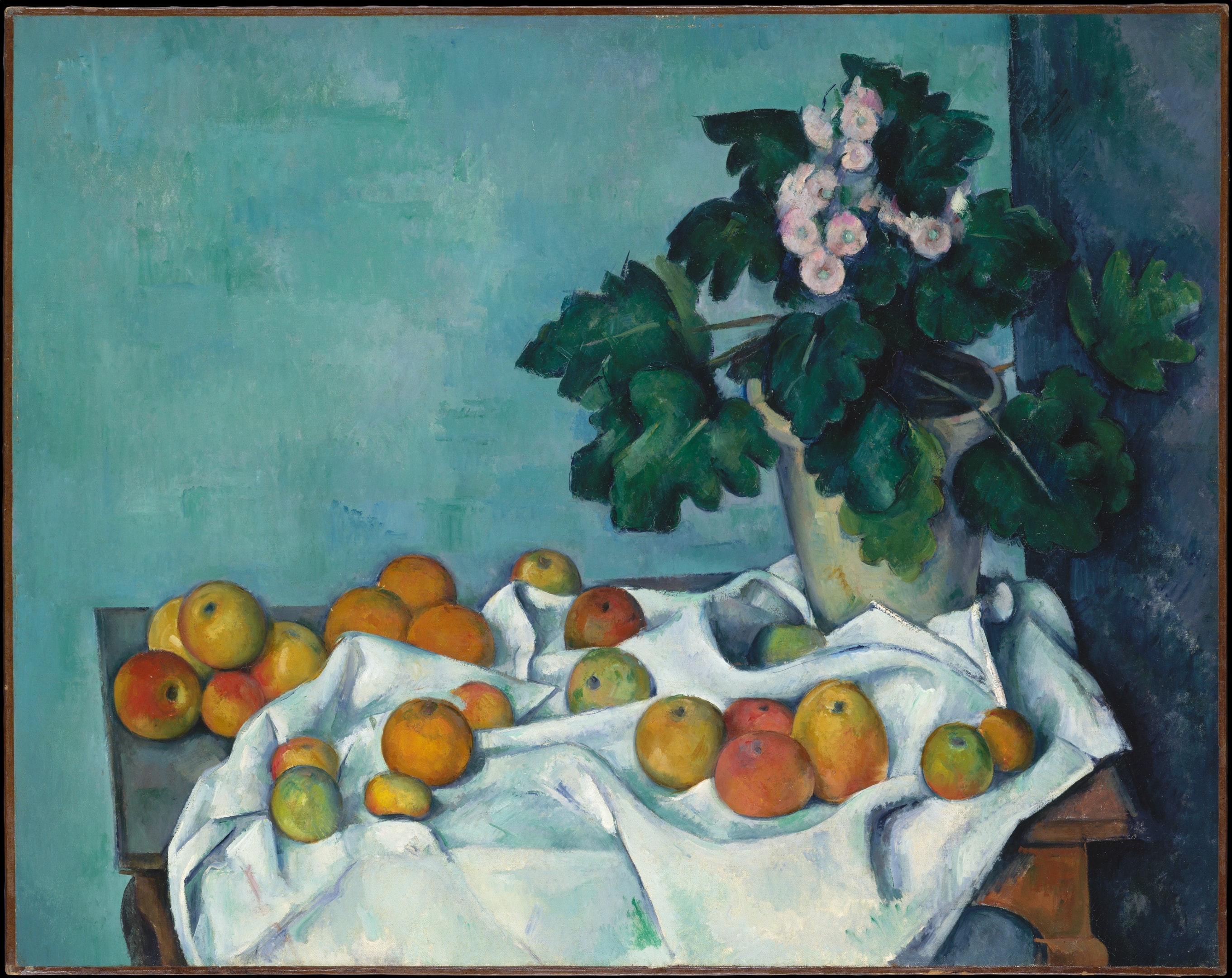
- Title and Creator: Still Life with Apples and a Pot of Primroses by Paul Cézanne.
- Artist’s Contribution: Cézanne’s exploration of form and perspective laid the groundwork for modern art movements.
- Creation Period: 1890, during the late Impressionist era.
- Cultural Context: Reflects a move towards abstraction and a focus on structural composition.
- Main Theme: A carefully arranged still life with apples, a pot of primroses, and a patterned cloth.
- Key Elements: Features layered textures and a harmonious colour palette.
- Techniques Used: Subtle tonal shifts and precise brushwork emphasise depth.
- Symbolism: The apples symbolise vitality, while the primroses represent renewal.
- Significance: Demonstrates Cézanne’s ability to balance complexity and simplicity.
- Impact: Influenced Cubism and inspired countless modern artists.
Still Life with Peaches and Grapes (Raphaelle Peale, 1816)
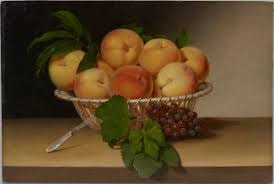
- Title and Creator: Still Life with Peaches and Grapes by Raphaelle Peale.
- Artist’s Contribution: Recognised as America’s first professional still life painter.
- Creation Period: Early 19th century, during the rise of American art.
- Cultural Context: Reflects the burgeoning American interest in still life as a serious art form.
- Main Theme: A simple yet elegant display of peaches and grapes on a wooden table.
- Key Elements: Features realistic textures and naturalistic lighting.
- Techniques Used: Delicate glazing adds luminosity and softness.
- Symbolism: Represents abundance and the beauty of nature.
- Significance: One of Peale’s finest works, highlighting his technical skill.
- Impact: Helped establish still life painting in America.
Still Life with Skull and Writing Quill (Pieter Claesz, 1628)

- Title and Creator: Still Life with Skull and Writing Quill by Pieter Claesz.
- Artist’s Contribution: A master of vanitas painting, Claesz used symbolism to explore life’s transience.
- Creation Period: Early 17th century, during the height of vanitas art.
- Cultural Context: Reflects the era’s focus on mortality and spiritual reflection.
- Main Theme: The inevitability of death and the ephemeral nature of knowledge.
- Key Elements: Features a skull, writing quill, and timepiece.
- Techniques Used: Muted tones and soft lighting evoke a reflective mood.
- Symbolism: The skull represents mortality, while the quill symbolises knowledge.
- Significance: A quintessential vanitas still life.
- Impact: Reinforced moralistic themes in art, resonating with viewers.
Still Life with Silver Pitcher (Francisco de Zurbarán, 1630)
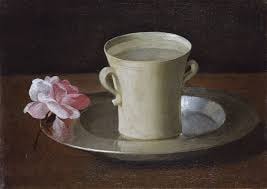
- Title and Creator: Still Life with Silver Pitcher by Francisco de Zurbarán.
- Artist’s Contribution: Zurbarán’s still lifes are noted for their simplicity and spiritual depth.
- Creation Period: 1630, during the Spanish Baroque period.
- Cultural Context: Reflects the austerity and devotion of Spanish religious art.
- Main Theme: A serene arrangement of objects, including a silver pitcher and fruits.
- Key Elements: Features stark contrasts between light and shadow.
- Techniques Used: Chiaroscuro creates dramatic depth and focus.
- Symbolism: The silver pitcher symbolises purity and devotion.
- Significance: Showcases Zurbarán’s ability to infuse everyday objects with spiritual meaning.
- Impact: Influenced Baroque still life traditions in Spain.
Still Life with a Basket of Bread (Salvador Dalí, 1926)
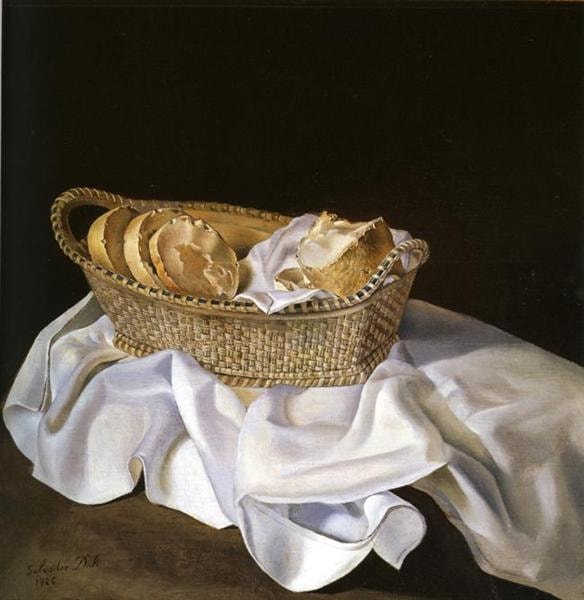
- Title and Creator: Still Life with a Basket of Bread by Salvador Dalí.
- Artist’s Contribution: Before embracing surrealism, Dalí explored classical techniques in works like this.
- Creation Period: 1926, during Dalí’s early career.
- Cultural Context: Reflects a transitional period in Dalí’s artistic development.
- Main Theme: A realistic depiction of a basket of bread, highlighting texture and light.
- Key Elements: Features a simple basket with carefully detailed bread.
- Techniques Used: Precise realism with a focus on texture.
- Symbolism: Bread symbolises sustenance and simplicity.
- Significance: A precursor to Dalí’s later surrealist works.
- Impact: Demonstrates Dalí’s mastery of traditional techniques.
Still Life: Vase with Fifteen Sunflowers (Vincent van Gogh, 1888)
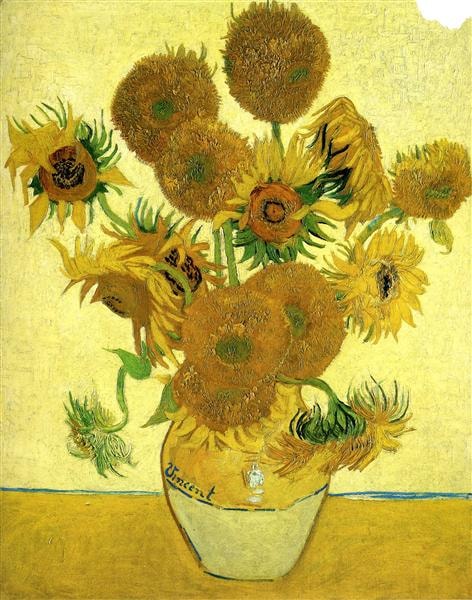
- Title and Creator: Vase with Fifteen Sunflowers by Vincent van Gogh.
- Artist’s Contribution: Van Gogh’s sunflowers are among his most iconic works, showcasing his innovative use of colour and texture.
- Creation Period: 1888, during his prolific period in Arles.
- Cultural Context: Reflects van Gogh’s fascination with nature and the symbolic potential of flowers.
- Main Theme: A radiant display of sunflowers in a simple vase.
- Key Elements: Features a vibrant yellow palette and dynamic brushstrokes.
- Techniques Used: Impasto adds texture and depth, while bold hues create warmth.
- Symbolism: The sunflowers symbolise joy, vitality, and friendship.
- Significance: Represents van Gogh’s ability to imbue simple subjects with emotional intensity.
- Impact: Cemented van Gogh’s legacy as a master of still life painting.
The Ray (Jean-Baptiste-Siméon Chardin, 1728)
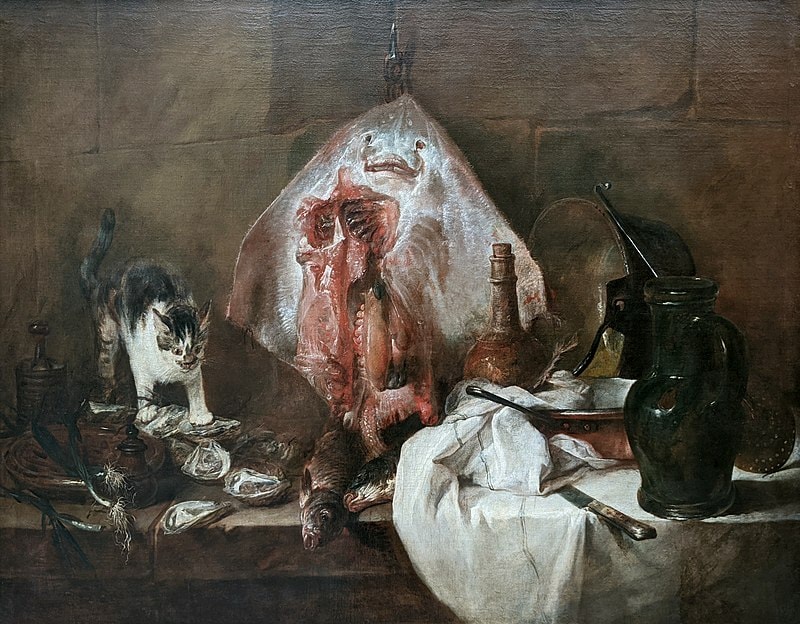
- Title and Creator: The Ray by Jean-Baptiste-Siméon Chardin.
- Artist’s Contribution: Renowned for his ability to elevate ordinary objects to poetic works of art.
- Creation Period: 1728, during the French Rococo period.
- Cultural Context: Reflects a shift from opulence to an appreciation for everyday life.
- Main Theme: A raw ray fish, cooking utensils, and a variety of kitchen objects.
- Key Elements: A stark arrangement featuring rich textures and muted tones.
- Techniques Used: Masterful chiaroscuro and subtle tonal gradation.
- Symbolism: The ray fish symbolises nature’s beauty and man’s dominion over it.
- Significance: A quintessential example of Chardin’s ability to find beauty in the mundane.
- Impact: Cemented Chardin’s legacy as a pioneer of still life in France.
Still Life with Partridge and Pears (Francisco de Zurbarán, 1635)
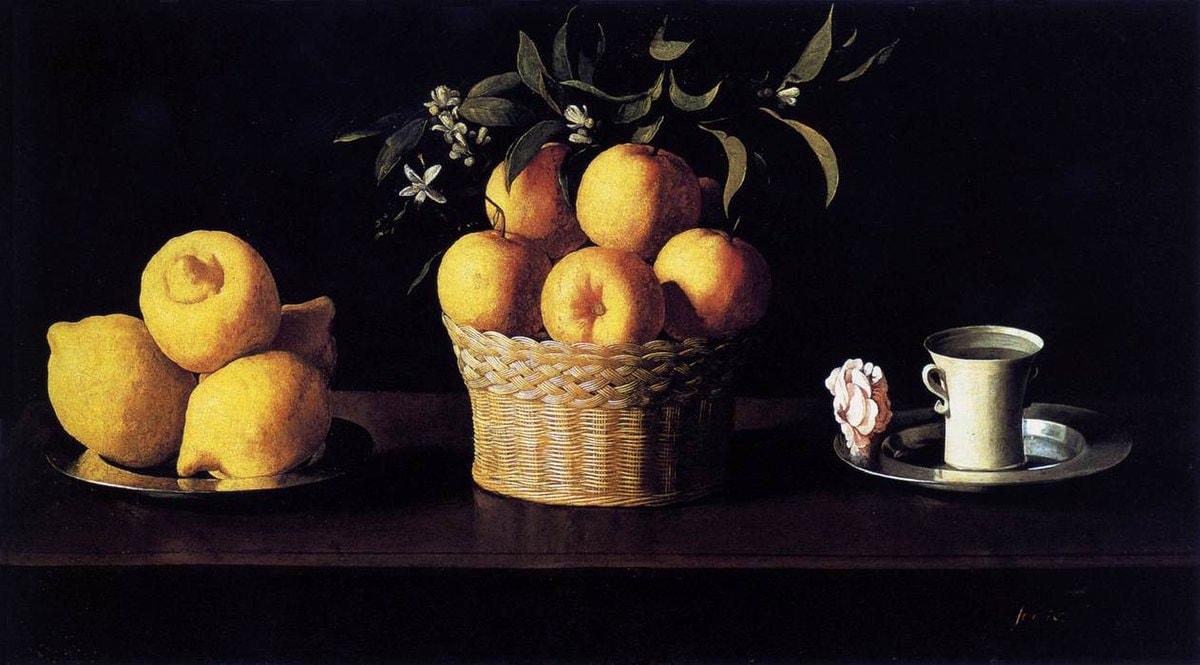
- Title and Creator: Still Life with Partridge and Pears by Francisco de Zurbarán.
- Artist’s Contribution: Celebrated for his ability to imbue still lifes with a spiritual quality.
- Creation Period: 1635, during the Spanish Baroque period.
- Cultural Context: Reflects the austere and devotional aspects of Spanish art.
- Main Theme: A partridge, pears, and other kitchen elements arranged with precision.
- Key Elements: Stark contrasts and meticulous detailing.
- Techniques Used: Dramatic chiaroscuro to create depth and focus.
- Symbolism: The partridge symbolises sacrifice and the pears signify abundance.
- Significance: A stunning blend of simplicity and spiritual meaning.
- Impact: Influenced the tradition of religiously infused still lifes in Spain.
Flower Still Life (Ambrosius Bosschaert the Elder, 1614)
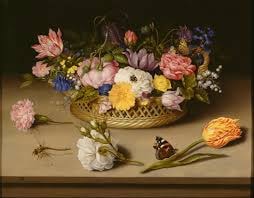
- Title and Creator: Flower Still Life by Ambrosius Bosschaert the Elder.
- Artist’s Contribution: A pioneer of floral still life painting during the Dutch Golden Age.
- Creation Period: 1614, amid the fascination with botany and horticulture.
- Cultural Context: Reflects the Dutch interest in exotic flowers and scientific exploration.
- Main Theme: A detailed bouquet of various flowers in a glass vase.
- Key Elements: Vibrant colours and meticulous detailing.
- Techniques Used: Delicate brushwork and balanced composition.
- Symbolism: Flowers symbolise the fleeting nature of life and beauty.
- Significance: A masterpiece that set the standard for floral still life.
- Impact: Elevated the genre of floral painting and inspired many contemporaries.
Still Life With Fish and Cat (Clara Peeters , c.1620)
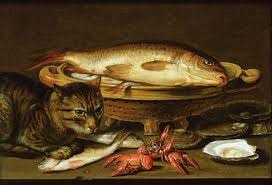
- Title and Creator: Still Life with Fish and Cat by Clara Peeters.
- Artist’s Contribution: One of the few prominent female artists of the Dutch Golden Age.
- Creation Period: Circa 1620, during the rise of detailed and symbolic still lifes.
- Cultural Context: Reflects the Dutch fascination with domestic scenes.
- Main Theme: A detailed arrangement of fish, a cat, and kitchen utensils.
- Key Elements: Realistic textures and dynamic composition.
- Techniques Used: Trompe-l’œil to enhance realism and texture.
- Symbolism: The fish symbolises sustenance, while the cat hints at mischief.
- Significance: Highlights Peeters’s skill in blending narrative with detail.
- Impact: Helped establish women’s presence in the art world.
Still Life with Flowers, Goblet, Dried Fruit, and Pretzels (Clara Peeters)
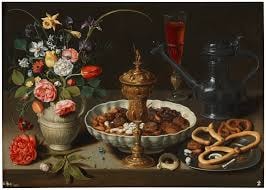
- Title and Creator: Still Life with Flowers, Goblet, Dried Fruit, and Pretzels by Clara Peeters.
- Artist’s Contribution: Known for her detailed and symbolic compositions.
- Creation Period: Early 17th century, during the Dutch Golden Age.
- Cultural Context: Reflects domestic wealth and the emerging art market.
- Main Theme: A table laden with flowers, a goblet, and food items.
- Key Elements: Intricate textures and reflective surfaces.
- Techniques Used: Glazing for luminosity and trompe-l’œil effects.
- Symbolism: The pretzels symbolise hospitality, while the goblet hints at luxury.
- Significance: A testament to Peeters’s technical and narrative skills.
- Impact: Reinforced still life’s role in celebrating domestic life.
Still Life With Melon And Pears (Luis Meléndez, 1772)
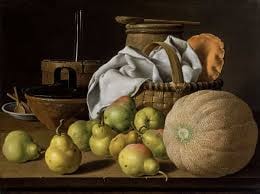
- Title and Creator: Still Life with Melon and Pears by Luis Meléndez.
- Artist’s Contribution: Regarded as one of Spain’s greatest still life painters.
- Creation Period: 1772, during the Spanish Enlightenment.
- Cultural Context: Reflects the era’s focus on scientific observation and naturalism.
- Main Theme: A simple arrangement of fruits on a wooden table.
- Key Elements: Detailed textures and vibrant colours.
- Techniques Used: Precise realism and subtle lighting.
- Symbolism: The melon and pears symbolise abundance and natural beauty.
- Significance: A showcase of Meléndez’s technical brilliance.
- Impact: Elevated Spanish still life painting to new heights.
Still Life With A Turkey Pie (Pieter Claesz)
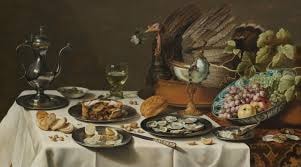
- Title and Creator: Still Life with a Turkey Pie by Pieter Claesz.
- Artist’s Contribution: A leading figure in Dutch vanitas still life painting.
- Creation Period: Mid-17th century, during the Dutch Golden Age.
- Cultural Context: Reflects wealth and indulgence, tempered by moral reflection.
- Main Theme: A lavish spread featuring a turkey pie, silverware, and other delicacies.
- Key Elements: Intricate details and rich textures.
- Techniques Used: Chiaroscuro to create depth and emphasis.
- Symbolism: The turkey pie represents opulence, while the extinguished candle hints at life’s brevity.
- Significance: A masterpiece of Dutch vanitas art.
- Impact: Highlights the tension between material wealth and spiritual values.
Techniques in Still Life Paintings
Trompe-l’œil
A technique designed to deceive the eye, creating a three-dimensional illusion on a two-dimensional surface. Artists used this method to bring objects to life with astounding realism.
Chiaroscuro
The dramatic interplay of light and shadow adds depth and realism to still life compositions. This technique was widely employed during the Baroque period to enhance visual contrast and emotional impact.
Impasto and Glazing
- Impasto: Thick layers of paint create texture and add a tactile dimension to the artwork.
- Glazing: Thin, translucent layers of paint create luminous effects and depth.
Composition and Perspective
Delicate arrangement of objects guides the viewer’s eye through the painting, often using diagonal lines, symmetry, or dynamic asymmetry to achieve balance and harmony.
Symbolism in Still Life Paintings
Common Themes and Motifs
Still life paintings frequently include objects that carry symbolic meanings:
- Fruits and Flowers: Represent abundance, beauty, and the fleeting nature of life.
- Skulls and Extinguished Candles: Symbols of mortality and the passage of time.
- Books and Instruments: Represent knowledge and the arts.
Religious and Moral Symbolism
- Bread and Wine: Often signify the Eucharist in Christian art.
- Hourglasses and Timepieces: Reflect on the brevity of life and the importance of piety.
- Vanitas Symbols: Remind viewers of life’s transience and the futility of earthly possessions.
Conclusions
Still life paintings provide a rich meaning of expressing art, various symbolism of familiar objects, and technical mastery. Getting to know these 20 famous still life paintings, will help you gain a deeper appreciation for each art form during their time.
For more art-related insights on famous paintings, visit MintSuper Art and explore our collections.

